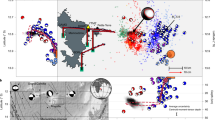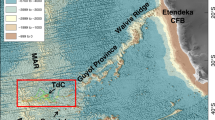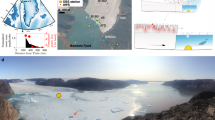Abstract
Our understanding of submarine volcanic eruptions has improved substantially in the past decade owing to the recent ability to remotely detect such events1 and to then respond rapidly with synoptic surveys and sampling at the eruption site. But these data are necessarily limited to observations after the event2. In contrast, the 1998 eruption of Axial volcano on the Juan de Fuca ridge3,4 was monitored by in situ sea-floor instruments5,6,7. One of these instruments, which measured bottom pressure as a proxy for vertical deformation of the sea floor, was overrun and entrapped by the 1998 lava flow. The instrument survived—being insulated from the molten lava by the solidified crust—and was later recovered. The data serendipitously recorded by this instrument reveal the duration, character and effusion rate of a sheet flow eruption on a mid-ocean ridge, and document over three metres of lava-flow inflation and subsequent drain-back. After the brief two-hour eruption, the instrument also measured gradual subsidence of 1.4 metres over the next several days, reflecting deflation of the entire volcano summit as magma moved into the adjacent rift zone. These findings are consistent with our understanding of submarine lava effusion, as previously inferred from seafloor observations, terrestrial analogues, and laboratory simulations8,9,10,11.
This is a preview of subscription content, access via your institution
Access options
Subscribe to this journal
Receive 51 print issues and online access
$199.00 per year
only $3.90 per issue
Buy this article
- Purchase on Springer Link
- Instant access to full article PDF
Prices may be subject to local taxes which are calculated during checkout



Similar content being viewed by others
References
Fox, C. G., Dziak, R. P., Matsumoto, H. & Schreiner, A. E. Potential for monitoring low-level seismicity on the Juan de Fuca Ridge using military hydrophone arrays. Mar. Technol. Soc. J. 27, 22–30 (1994).
Perfit, M. R. & Chadwick, W. W. Jr in Faulting and Magmatism at Mid-Ocean Ridges (eds Buck, W. R., Delaney, P. T., Karson, J. A. & Lagabrielle, Y. 59–116 (AGU Geophysical Monograph 106, American Geophysical Union, Washington DC, 1998).
Dziak, R. P. & Fox, C. G. The January 1998 earthquake swarm at Axial Volcano, Juan de Fuca Ridge: Hydroacoustic evidence of seafloor volcanic activity. Geophys. Res. Lett. 26, 3429–3432 (1999).
Embley, R. W., Chadwick, W. W. Jr, Clague, D. & Stakes, D. The 1998 eruption of Axial Volcano: Multibeam anomalies and seafloor observations. Geophys. Res. Lett. 26, 3425–2428 (1999).
Fox, C. G. In situ ground deformation measurements from the summit of Axial Volcano during the 1998 volcanic episode. Geophys. Res. Lett. 26, 3437–3440 (1999).
Chadwick, W. W. Jr, Embley, R. W., Milburn, H. B., Meinig, C. & Stapp, M. Evidence for deformation associated with the 1998 eruption of Axial Volcano, Juan de Fuca Ridge, from acoustic extensometer measurements. Geophys. Res. Lett. 26, 3441–3444 (1999).
Baker, E. T., Fox, C. G. & Cowen, J. P. In situ observations of the onset of hydrothermal discharge during the 1998 submarine eruption of Axial Volcano, Juan de Fuca Ridge. Geophys. Res. Lett. 26, 3445–3448 (1999).
Griffiths, R. W. & Fink, J. H. Solidification and morphology of submarine lavas: A dependence on extrusion rate. J. Geophys. Res. 97, 19729–19737 (1992).
Gregg, T. K. P. & Fink, J. H. Quantification of submarine lava-flow morphology through analog experiments. Geology 23, 73–76 (1995).
Gregg, T. K. P. & Chadwick, W. W. Jr. Submarine lava-flow inflation: A model for the formation of lava pillars. Geology 24, 981–984 (1996).
Chadwick, W. W. Jr, Gregg, T. K. P. & Embley, R. W. Submarine lineated sheet flows: A unique lava morphology formed on subsiding lava ponds. Bull. Volcanol. 61, 194–206 (1999).
Fox, C. G. Evidence of active ground deformation on the mid-ocean ridge: Axial Seamount, Juan de Fuca Ridge, April-June, 1988. J. Geophys. Res. 95, 12813–12822 (1990).
Gregg, T. K. P. & Fornari, D. J. Long submarine lava flows: Observations and results from numerical modeling. J. Geophys. Res. 103, 27517–27532 (1998).
Wadge, G. The variation of magma discharge during basaltic eruptions. J. Volcanol. Geotherm. Res. 11, 139–168 (1981).
Lockwood, J. P. & Lipman, P. W. Holocene eruptive history of Mauna Loa Volcano. Prof. Pap. US Geol. Surv. 1350, 509–536 (1987).
Wolfe, E. W., Neal, C. A., Banks, N. G. & Duggan, T. J. Geologic observations and chronology of eruptive events. Prof. Pap. US Geol. Surv. 1463, 1–98 (1988).
Rowland, S. K. & Walker, G. P. L. Pahoehoe and a'a in Hawaii: Volumetric flow rate controls the lava structure. Bull. Volcanol. 52, 615–628 (1990).
Thordarson, T. & Self, S. The Laki (Skaftár Fires) and Grímsvötn eruptions in 1783-1785. Bull. Volcanol. 55, 233–263 (1993).
Mogi, K. Relations between the eruptions of various volcanoes and the deformation of the ground surfaces around them. Bull. Earthquake Res. Inst. Univ. Tokyo 36, 99–134 (1958).
West, M. E., Menke, W. & Tolstoy, M. Massive magma reservoir beneath Axial volcano, Juan de Fuca ridge. Nature (submitted).
Acknowledgements
We thank H. Milburn, C. Meinig and P. McLain for helping to build, maintain and rescue the VSM2 instrument; the ROPOS group and the crews of the NOAA ship Ron Brown and RV Thompson for their help with successful recovery of VSM2; and S. Carbotte and J. Fink for comments on the manuscript. This work was supported by the NOAA Vents Program and the West Coast and Polar Regions Undersea Research Center.
Author information
Authors and Affiliations
Corresponding author
Rights and permissions
About this article
Cite this article
Fox, C., Chadwick, W. & Embley, R. Direct observation of a submarine volcanic eruption from a sea-floor instrument caught in a lava flow. Nature 412, 727–729 (2001). https://doi.org/10.1038/35089066
Received:
Accepted:
Issue Date:
DOI: https://doi.org/10.1038/35089066
This article is cited by
-
Experimental evidence characterizing pressure fluctuations at the seafloor-water interface induced by an earthquake
Scientific Reports (2018)
-
Seafloor deformation and forecasts of the April 2011 eruption at Axial Seamount
Nature Geoscience (2012)
-
Seismic precursors and magma ascent before the April 2011 eruption at Axial Seamount
Nature Geoscience (2012)
-
Repeat bathymetric surveys at 1-metre resolution of lava flows erupted at Axial Seamount in April 2011
Nature Geoscience (2012)
-
Active submarine eruption of boninite in the northeastern Lau Basin
Nature Geoscience (2011)
Comments
By submitting a comment you agree to abide by our Terms and Community Guidelines. If you find something abusive or that does not comply with our terms or guidelines please flag it as inappropriate.



